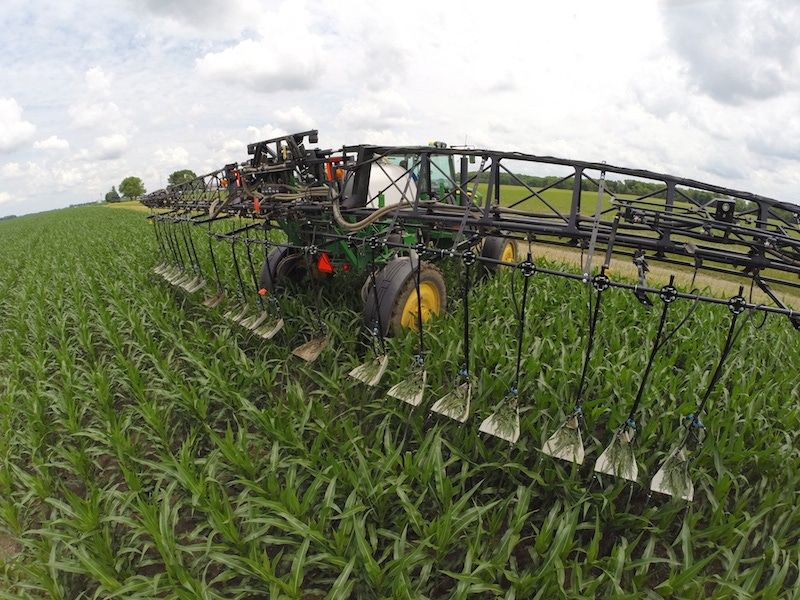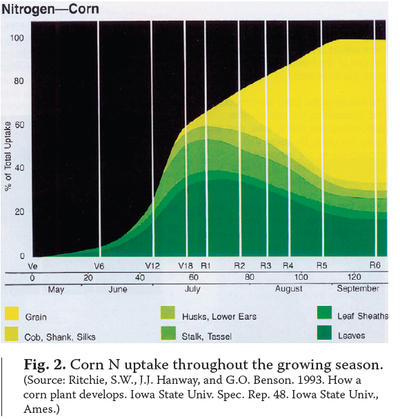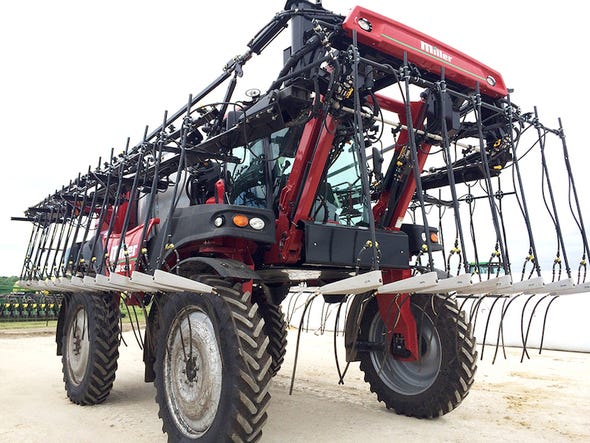
Answers are unfolding to our nitrogen nightmares, but they beg for thinking differently. Of the four Rs of nitrogen BMPs (the right Rate, Time, Place, Source), most research addresses nitrogen Rate. Placement and timing are the next wave of nitrogen solutions; and it’s been gratifying to see so many of you sidedressing this year.
The trouble is, the correlation between nitrogen Rate and yield hinges on Mother Nature’s whims. For starters, check out the Y Drop applicator, which surface applies sidedress nitrogen 2-3 inches from the corn row, above the roots. Still being tested by third-party researchers, it attaches to almost any high-clearance applicator. Your sidedress season could expand to match the corn plant’s nitrogen-use schedule, if Y Drop proves to deliver what it promises. You’ll see in the nearby visual that the plant needs nitrogen the most when it’s most difficult for you to deliver it, and when the water spigot’s mostly turned off. In dry seasons, the company claims that moisture from a heavy dew or light rain helps nutrients placed by Y Drop move into the root zone and become available.

Applying nitrogen later in the season, when plants need it, addresses the Right Time part of nitrogen stewardship. New equipment gives you more options to clear taller crops. Credit: Iowa State University
It will be awhile before Y Drop and other technologies can be scientifically verified for sure. Read details on the first generation of trials, which are promising but preliminary.
The point is that “there is no one-size fits all” nitrogen answer, says Pat Reeg, director of the Iowa Soybean Association On Farm Network, which has done preliminary tests of Y Drop.
The trouble is, the Washington, DC regulatory machine speaks a one-size-fits-all language. Water-quality concerns over water nitrate contamination, fomented by five years of record precip extremes, publicizes the complexity of nitrogen management. It catches us with our drawers down without the public or legislators understanding that nitrogen is a moving target.
From an environmental and public relations perspective, if we sidedress and it does not rain, that creates a worse environmental threat to water-nitrate levels than does fall anhydrous nitrogen application, scientists tell me. If you coulter-inject/sidedress in July and don’t get moisture, that nitrogen just sits there unused for lack of water to move it into the root zone, and it’s vulnerable to leaching into the water table before the next season. So news of more targeted sidedress placement is good news on two fronts: your bottom line and our public image.

Two-pronged applicator, Y Drop, puts sidedress nitrogen 2-3 inches from corn roots, addressing the Placement aspect of nitrogen stewardship. Photo: Y Drop
But does Washington comprehend that no one can get a whole growing season right by nitrogen rate alone? Getting the nitrogen rate right is all about what unfolds during the growing season. That’s where another new tool, Adapt-N, may play a valuable role. The highly scientific nitrogen model adjusts nitrogen rate prescriptions every 24 hours, as weather changes. “No one would accept 30-70% germination rate on their seed corn, yet corn growers settle for 30-70% nitrogen efficiency, says Corn + Soybean Digest veteran writer Jim Ruen, in writing about the nitrogen gamble.
To illustrate, consider these two opposite nitrogen scenarios, both with high-organic-matter soils: One is a low-lying, high-organic-matter soil zone that releases a lot of nitrogen back later in the season through mineralization (organic matter decomposes and releases nitrogen). Compare that to a high-organic-matter soil zone in standing water, where nitrogen is lost to denitrification. Both soils are high organic matter, but they require opposite in-season nitrogen-management scenarios.
Regulating the rate of nitrogen applied alone will not solve the problem. Nitrogen placement and timing are key BMPs that I’m glad to see entering the scientific and production mainstream. You’ll be reading a lot about them in the Corn+Soybean Digest.
About the Author(s)
You May Also Like






